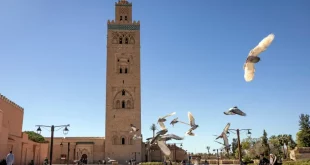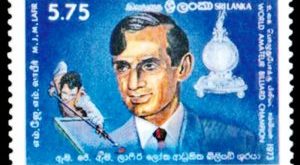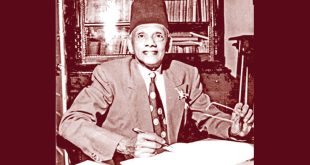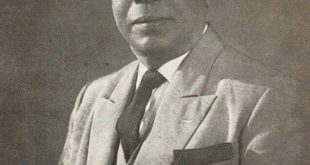 I am honoured by the invitation to deliver this lecture, particularly because Dr. Jayah was born in Galagedera, my electorate. His father was a Police Officer then attached to the Galagedera Police Station. There is also another connection. My father had a collection of Aubrey Collette’s cartoons and as a youngster I spent much time studying them. One of those cartoons showed in very graphic fashion the role played by Dr. Jayah in the politics of his time. The cartoon showed two ladies taking their babies out for a stroll. One lady was Pandit Nehru and the other was D S Senanayake. They were pushing their two prams side by side. In Pandit Nehru’s pram Jinnah was shouting, crying and creating a big commotion. He is shouting at the mother. But in the other pram pushed by D S Senanayake, T B Jayah was very peacefully sucking this thumb and looking admiringly at the mother. Collettes cartoon showed the difference between the communal problem that existed in India at that time, leading finally to the partition of British India, and the very cordial relations that existed in Sri Lanka between the national leaders of the country and the Muslim minority. To my young mind it made clear that amity among the different communities in Sri Lanka was a great blessing.
I am honoured by the invitation to deliver this lecture, particularly because Dr. Jayah was born in Galagedera, my electorate. His father was a Police Officer then attached to the Galagedera Police Station. There is also another connection. My father had a collection of Aubrey Collette’s cartoons and as a youngster I spent much time studying them. One of those cartoons showed in very graphic fashion the role played by Dr. Jayah in the politics of his time. The cartoon showed two ladies taking their babies out for a stroll. One lady was Pandit Nehru and the other was D S Senanayake. They were pushing their two prams side by side. In Pandit Nehru’s pram Jinnah was shouting, crying and creating a big commotion. He is shouting at the mother. But in the other pram pushed by D S Senanayake, T B Jayah was very peacefully sucking this thumb and looking admiringly at the mother. Collettes cartoon showed the difference between the communal problem that existed in India at that time, leading finally to the partition of British India, and the very cordial relations that existed in Sri Lanka between the national leaders of the country and the Muslim minority. To my young mind it made clear that amity among the different communities in Sri Lanka was a great blessing.
Mr. D S Senanayake, though he had a walrus mustache even as a mother, in Collettes cartoon looked very comfortable while Jawaharlal Nehru looked very uncomfortable, even angry at his ward in the pram.
My friend Mr. Azwer gave me a wonderful biography of Jayah written by Dr. Jaladeen. It is very well written and very well researched and contains a lot of quotations from Jayah’s speeches. Based on that information I like to refer today to three aspects of Jayah’s contribution. The first is Jayah’s personal career. The second aspect is his contribution to education, particularly Muslim education and the third aspect is his contribution to amicable political and communal relationships in this country at that time.
If you look at his personal emergence into prominence, there is one lesson of great importance, not only to the Muslims but to all young people of this country, particularly those who come from rural areas and less affluent homes. The lesson is that education is the path to success and fulfillment. If you look at Jayah’s life, he rose step by step to the highest point of eminence because of his education and his love of knowledge.
He changed many schools. He may have started in the Kindergarten at Galagedera but he went from school to school as his father was transferred from Police station to station. Finally he came to St.Thomas’s. He was a great classics scholar and he won all the English prizes in school. What distinguished him was his dedication to education. And you will find all those Muslim leaders that we remember today, T.B. Jayah, Dr. Kaleeel, Mr. A M A Aziz and Dr. Baduideen Mahamud – all of them dedicated their lives to education, particularly, to further the educational prospects of the Muslim community.
I think very few now know of the abysmal level of education among the Muslim community prior to Independence. In fact it would not be wrong to say that at that time Muslim leaders were more interested in training children for commercial activities; education for women was actively discouraged. There were so many barriers to be crossed. So, what Dr. Jayah undertook was a superhuman task. He had to change the mindset of a whole generation of Muslims who did not put so much of emphasis on education. So we can see him as one of the first to receive higher education, to derive a benefit from education and to go to the highest levels of society through education. Having got there he saw the value of that education not only for his community but for all the other communities in this country. That is how he became a teacher at Ananda College.
In that book we have some very interesting anecdotes about Jayah and future left leaders. He taught N M Perera, Philip Gunawardena, Robert Gunawardena and many other Anandians who later joined the LSSP. According to Jayah’s biographer Philip Gunawardena was a bright but difficult student. He challenged his teachers, Mr. P De S Kularatne who was the principal at that time decided to sack him. He told Dr. Jayah, who was then Philip’s teacher, ‘I’ll have to get rid of this boy’, but Jayah had told the Principal, "Sir give him one more chance. If he causes trouble one more time not only will he be expelled, I give you my word, I will give up teaching in this school and find another job". So on that compassionate plea the Principal gave another chance, and of course we later know what a wonderful and brilliant contribution Philip Gunawardena made. This is in addition to the contribution he made by producing our outstanding and decent collegue Mr. Dinesh Gunawardene. So that was the calibre of person Jayah was and I think all of us will remember great teachers like that.
They were outstanding teachers who would always stand up for the pupil. Taking a special interest in the child with potential, is a sign of a very good teacher, and I think Dr. Jayah was such an outstanding teacher.
I will now turn to his contribution to Muslim education. As I said before it was a very difficult journey. The elders in the community were not very convinced that education was necessary. Secondly, even basic facilities were not there.
When Dr. Jayah started Zahira, facilities were primitive. So it was for all the other schools. If you take Ananda and Nalanda or Christian Schools, Muslim or Hindu schools, at the beginning material facilities were very limited. Sometime ago I was the Minister of Education. I always said that while material facilities like three and four storied buildings, are necessary, what is most important is a dedicated Principal and staff. There must be a teaching staff and an environment and culture dedicated to the efficient transference of knowledge. That is more important than five storied buildings.
Unfortunately today everybody is thinking of education as providing more and more buildings. Nobody talks of high quality dedicated teachers. Very few talk about the calibre of the teachers we are producing. Those days before the State took over everything including education, there was a lack of material benefits. Its true that private schools could not have got those benefits without State assistance. But I am doubtful whether after taking over we are producing better teachers or more committed teachers.
When they were short of funds educationists like Dr. Malalasekera, Mr. Jayah and Mr. P de S Kularatne went to their co-religionists or to their friends and donors for support, not to the State. So here is a leader who not only saw the value of education but was himself a teacher and was able to create a school which was a credit to the Muslim community. I read in that book, a long essay written by Mr. A M A Aziz about the teaching methods of Dr. Jayah.
Among the politicians of that time, there were many dedicated teachers. Some taught in top schools till they got through Law College. Also many of those who later turned out to be great lawyers had their beginnings in teaching – including people like Mr. H V Perera. HVP was a Mathematics teacher while studying law; of course, that mathematical brain helped to make him a superb lawyer. T B Jayah made an educational revolution. I think at first, he persuaded his personal friends to send their children to this school. The school improved soon after. Later Mr. A M A Azeez who was a very distinguished civil servant gave up his job and became Principal of Zahira. That shocked the rich Muslim community, because they never expected a civil servant to give up everything and take up the cause of Muslim education. That was a salutary shock, a good injection to the system which awakened, particularly, the rich Muslim community, to the value of education.
Then we come to the role of Mr. T B Jayah in the politics of his time. When you study the pre-independence period of Asian countries, we find that the colonial regime challenged the national leaders to come up with a joint demand for independence. They said "unless all communities come together we cannot grant independence since we are the custodian of the interests of all". It was a very convenient mantra. If all the communities do not come together, we cannot leave. That was the strategy adopted. In Sri Lanka first there was an attempt to split the Kandyan representatives from the Low country representatives. When the representatives of the Low country were asking for more power to the legislature, then Governor Mc Callum turned to a delegation of Kandyan Councillors. Four Kandyan Councillors were sent to London to say that Low country Councillers do not really represent the whole Sinhala community. When the British were under pressure to give more and more power to local leaders all over the Asia, they advised us, quite hypocritically "you must all come together, otherwise we cannot leave this country to the tyranny of the majority community and go away". In Malaysia they said they cannot leave the country only to the Malays. In India they asked ‘What about the Muslims’? In Sri Lanka they asked Mr. D S Senanayake and his Ceylon National Congress ‘what about the Tamils and the Muslims’? So, the main concern of leading politicians of that period throughout Asia was to cultivate good relationships with all the communities and to persuade minority leaders that they should jointly ask for independence from the British. Thus the role of Mr. Jayah and the Muslim community became crucial during the negotiations for Independence. A similar ‘divide and rule’ strategy was followed by the British Colonialists in Africa. Here they were dealing with different tribes. In Kenya they said that the Kikuyu and Luo tribes must come together before the handing over of power. Kenyan leaders like Jomo Kenyatta tried hard to bring about inter-tribal amity. But finally it was the Man Man which forced the British to leave Kenya. In order to counter the British argument our national leaders responded with the a Pan-Sinhala Board of Ministers. In the State Council all members were elected to Committees and the elected Chairman of the Committee became a Minister. For example the father of free education C W W Kannangara was elected by his Committee and thereby he became a Minister. He was not an appointee of D S Senanayake. It is said that on the advice of Mr. Sundaralingam, who was a mathematical genius, Senanayake manipulated the system so that within each committee they could appoint a Sinhala Minister. This was to prove to the British, that the Sinhalese could go it alone if necessary. But it also meant that the minority communities would be upset with a Board which had no Tamil or Muslim Ministers. So Senanayake abandoned the Pan-Sinhala Board and opted for a conciliatory policy by forming the United National Party. The UNP was formed as a signal to the British that all the local committees were now united behind D S Senanayake. It was a way of getting away from earlier formations like the Sinhala Maha Sabha, Muslim Congress, Tamil Congress etc.
The role of Dr. T B Jayah becomes paramount because had he, or the Muslim community, sided with the British at that time, granting of Independence to Ceylon would have been postponed. It is only because the minorities agreed that there was a United Front called the UNP asking for Independence. But one man was against it. That was G G Ponnambalam who tried to extract his pound of flesh. He said I will sign on the dotted line only if you agree to "Fifty Fifty". That is 50% of the seats for the Sinhalese and 50% for the minorities. Only if you agree to that, he told D S Senanayake, will I support the call for independence. It was at this point that Jayah rejected the ‘fifty fifty’ formula. He said he preferred to work in trust, to work in faith and goodwill with the majority community. Thereby he totally undercut G G Ponnambalam’s "fifty fifty" cry. That was the death knell of "Fifty Fifty". If Jayah joined the "fifty fifty" cry at that time, Independence would have been postponed. That is my analysis of the situation as a student of the politics of that period. You have to remember that even the word Sinhala was erased from the political lexicon. S W R D Bandaranaike ditched the idea of the Sinhala Maha Saba and he first joined the UNP and later set up the Sri Lanka Freedom Party which too did not have racial connotations. Everybody felt that communial parties were counter-productive. In the dispatches to London, the British Governor would say they are calling themselves Muslim Congress or Sinhala Maha Sabha, or Tamil Congress. They call themselves by all sorts of names, they never come together. So quickly the United National Party was formed. The Sri Lanka Freedom Party was formed. Of course, L S S P and C P didn’t have any communal connotations. We see therefore that during that period Sinhala, Muslim and Tamil parties came together under the UNP. In England – if you say you are in the Labour Party nobody cares about your ethnic identity. If you say you are a Conservative Party member it is the same. So Jayah’s role in joining the UNP must be seen as a crucial event. Unfortunately this aspect has been neglected by the political commentators. In Sri Lanka D S Senanayake got the equation right. But in India they failed. Because they could not get that equation right in India Mr. Jinnah broke away. There is a very good book called the "The Sole Spokesman" by Ayesha Jalal, which is a biography of Jinnah. Jinnah faced a terrible dilemma In British India you had several Muslim majority States – U.P., Bengal and Punjab. In other States Muslims were in a minority. Mr. Jinnah had to plan a strategy to face this reality. Do we ask for more power to these States, in which case he gets more power in the Mislim States but no power in the non Muslim States?. So he had to always take a risk in Indian politics. He had to say one thing (give more power to the local authority in Muslim States) and in the non Muslim State, being afraid of the Hindus, he had to say don’t give so much of power to the periphery. He had to go on changing his tactics. It is long story but in Sri Lanka our leaders got it right, in India they did not get it right and it led inevitably to partition. One could argue that though we got it right in 1948, we couldn’t get it right afterwards. That is why separation came to British India by way of the birth of two States. We too had a separatist movement after Independence. Fortunately it has been crushed. So you can see a structure, a pattern in communal relations. This is how you should analyse politics, not just recording that this man said this and that man said that. We must analyse the pattern of political decision making in the post-Independence period. We have to remember that at a crucial time the Muslim community led by Jayah threw in their lot with the Sinhala and the majority of Tamil leaders. G G Ponnambalam was not recognized as the "Sole Spokesman" of the Tamils at that time or even afterwards. Ponnambalam did not persist with his opposition. On the national flag issue, he signed together with Jayah as a member of that Committee to adopt the present flag. Only Natesan didn’t agree. Ponnambalam later accepted Cabinet office under D S Senanayake. Therefore that it is very right that all of us should get together today and commemorate Dr. Jayah, whose achievements may not have been analysed in detail previously, but certainly deserves to be. When people begin to write the history of that period in an analytical way, there is no doubt that Dr. T B Jayah’s contribution will be given due recognition.
 Sri lanka Muslims Web Portal Diversity and Inclusiveness
Sri lanka Muslims Web Portal Diversity and Inclusiveness



